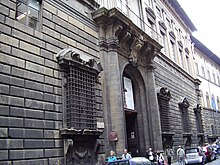
Florence is the capital city of the region of Tuscany in Central Italy. It is also the most populated city in Tuscany, with 360,930 inhabitants in 2023, and 984,991 in its metropolitan area.

The Pazzi were a powerful family in the Republic of Florence. Their main trade during the fifteenth century was banking. In the aftermath of the Pazzi conspiracy in 1478, members of the family were banished from Florence and their property was confiscated; the family name and coat-of-arms were permanently suppressed by order of the Signoria.

Santa Maria Novella is a church in Florence, Italy, situated opposite, and lending its name to, the city's main railway station. Chronologically, it is the first great basilica in Florence, and is the city's principal Dominican church.
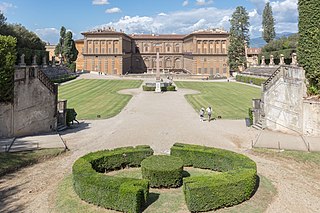
The Boboli Gardens is a historical park of the city of Florence that was opened to the public in 1766. Originally designed for the Medici, it represents one of the first and most important examples of the Italian garden, which later served as inspiration for many European courts. The large green area is a real open-air museum with statues of various styles and periods, ancient and Renaissance that are distributed throughout the garden. It also has large fountains and caves, among them the splendid Buontalenti grotto built by the artist, architect, and sculptor Bernardo Buontalenti between 1536 and 1608.

Bernardo Buontalenti, byname of Bernardo Delle Girandole, was an Italian stage designer, architect, theatrical designer, military engineer, artist, and inventor of Italian ice cream.

The House of Strozzi is the name of an ancient Florentine family, who like their great rivals the Medici family, began in banking before moving into politics. Until its exile from Florence in 1434, the Strozzi family was by far the richest in the city, and was rivaled only by the Medici family, who ultimately took control of the government and ruined the Strozzi both financially and politically. This political and financial competition was the origin of the Strozzi-Medici rivalry. Later, while the Medici ruled Florence, the Strozzi family ruled Siena, which Florence attacked, causing great animosity between the two families. Soon afterward, the Strozzi married into the Medici family, essentially giving the Medici superiority.

Bernardino Poccetti, also known as Barbatelli, was an Italian Mannerist painter and printmaker of etchings.

The Museo di Storia Naturale di Firenze is a natural history museum in 6 major collections, located in Florence, Italy. It is part of the University of Florence. Museum collections are open mornings except Wednesday, and all day Saturday; an admission fee is charged.

Santa Trinita is a Roman Catholic church located in front of the piazza of the same name, traversed by Via de' Tornabuoni, in central Florence, Tuscany, Italy. It is the mother church of the Vallumbrosan Order of Monks, founded in 1092 by a Florentine nobleman. South on Via de' Tornabuoni is the Ponte Santa Trinita over the river Arno; across the street is the Palazzo Spini Feroni.
Matteo Nigetti was an Italian architect and sculptor. He is an important Baroque architect in Florence.
Il rapimento di Cefalo was one of the first Italian operas. Most of the music was written by Giulio Caccini but Stefano Venturi del Nibbio, Luca Bati and Piero Strozzi also contributed. The libretto, by Gabriello Chiabrera, is in a prologue, five scenes and an epilogue and is based on the Classical myth of Cephalus and Aurora.

The Pucci family has been a prominent noble family in Florence over the course of many centuries. A recent notable member of this family was Emilio Pucci, an Italian fashion designer who founded a clothing company after World War II.

Palazzo dello Strozzino is a Renaissance palace in Florence, Italy. The stone Renaissance facade is located on Piazza degli Strozzi, diagonal to the Southeast corner of the imposing Palazzo Strozzi. The Northern façade on Via dei Anselmi houses the entrance to the Cinema Odeon.
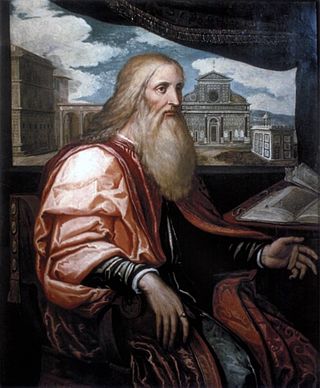
Giovanni Rucellai, known by his name with the patronymic Giovanni di Paolo Rucellai, was a member of a wealthy family of wool merchants in Renaissance Florence, in Tuscany, Italy. He held political posts under Cosimo and Lorenzo de' Medici, but is principally remembered for building Palazzo Rucellai and the Rucellai Sepulchre, for his patronage of the marble façade of the church of Santa Maria Novella, and as author of an important Zibaldone. He was the father of Bernardo Rucellai (1448–1514) and grandfather of Giovanni di Bernardo Rucellai (1475–1525).

The Casino Mediceo di San Marco is a late-Renaissance or Mannerist style palace located on Via Cavour number 57 and via San Gallo in Florence, region of Tuscany, Italy.

The Palazzo Pazzi, also known as the Palazzo della Congiura or Palazzo Pazzi-Quaratesi is a Renaissance-style palace. It is located on Via del Proconsolo 10 at the corner with Borgo Albizzi in Florence, region of Tuscany, Italy. The palace is between the Palazzo Nonfinito and the Palazzo Pazzi-Ammannati to the north.
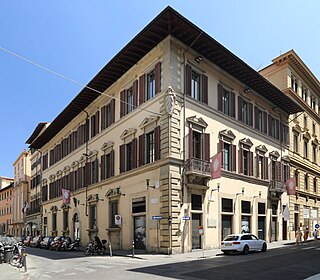
The Palazzo Vecchietti is a Renaissance architecture palace located on Via degli Strozzi number 4, near Piazza della Repubblica in the quartieri of Santa Maria Novella, city of Florence, region of Tuscany, Italy.
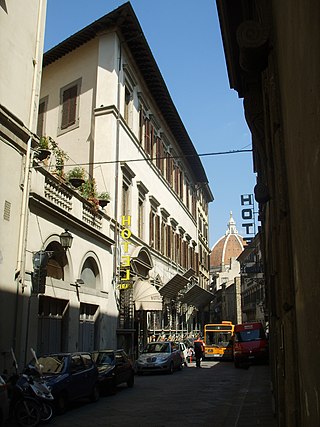
The Palazzo Venturi, once known as Palazzo Doni is a Renaissance-style palace located in central Florence, region of Tuscany, Italy. It located on via de' Banchi 2. The palace differs from the Palazzo Venturi Ginori on Via della Scala.
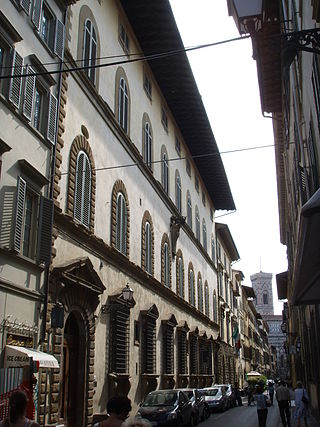
The Palazzo Gerini is a Renaissance-style palace located on via Ricasoli 42 in Florence, Italy.

Kneeling windows is a type of opening used from the fifteenth century, especially in the Tuscany area.



